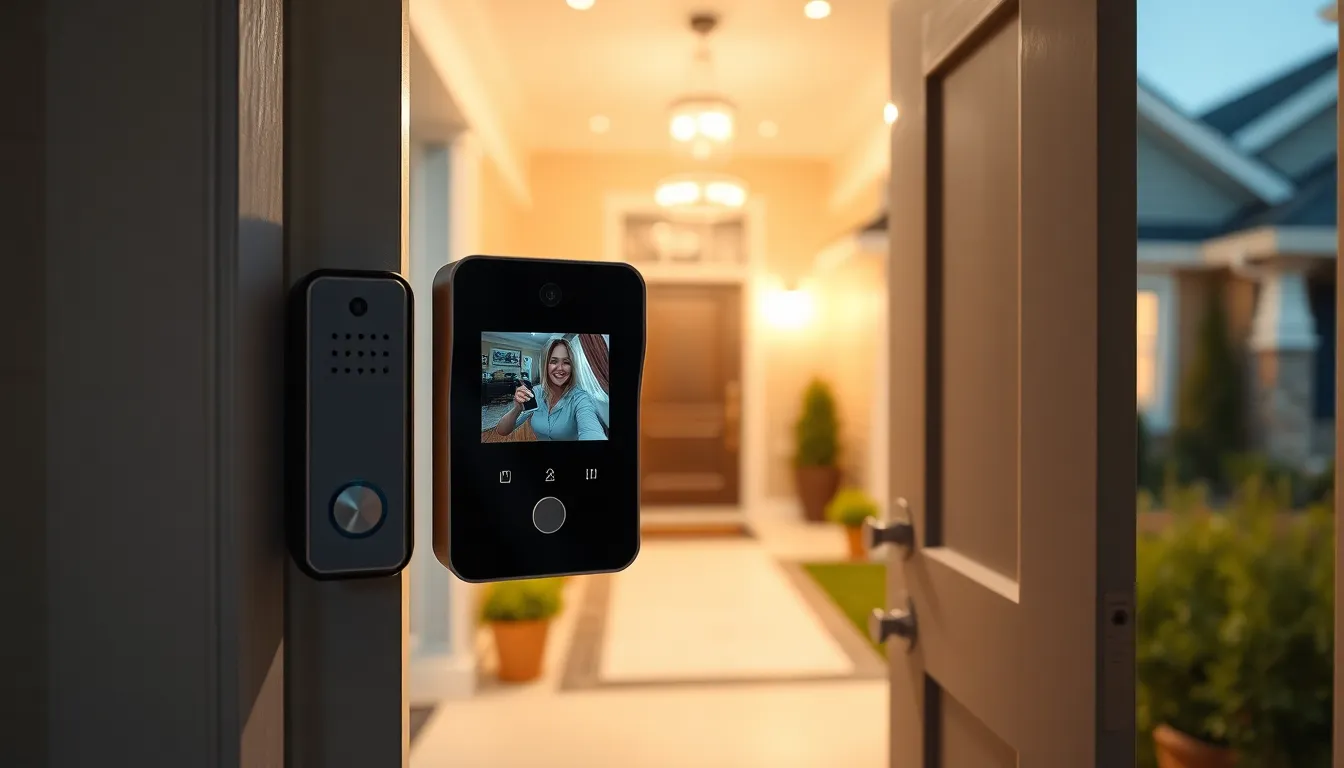In a world where doorbells are about as exciting as watching paint dry, smart intercom systems are here to spice things up. Imagine being able to chat with visitors from anywhere in your home—or even while lounging on a tropical beach. These high-tech gadgets not only enhance security but also make everyday interactions a breeze.
Gone are the days of awkwardly yelling through the door or running to answer the bell. With smart intercoms, you can see who’s at the door, talk to them, and even let them in—all from your smartphone. It’s like having a personal assistant who never takes a coffee break. So why settle for a plain old doorbell when you can upgrade to a smart intercom system that brings convenience and a touch of humor to your daily life?
Table of Contents
ToggleOverview of Smart Intercom Systems
Smart intercom systems integrate advanced technology, enhancing security and communication in modern homes. Users benefit from real-time video and audio access to visitors at their doors. With Wi-Fi connectivity, these devices allow remote interaction through smartphones or tablets.
Security features include motion detection and alerts, notifying homeowners of activity outside their properties. Many systems support two-way communication, making conversations with guests seamless and more interactive.
Smart intercoms often connect with other smart home devices like cameras and smart locks. This connectivity enables integrated security solutions, allowing homeowners to see who is at the door before opening it.
Some systems come equipped with facial recognition technology, distinguishing between known visitors and strangers. Enhanced accessibility features cater to individuals with disabilities, improving overall usability.
Installation processes typically involve simple setups, requiring minimal technical expertise. Users enjoy greater flexibility, as these systems can be easily relocated without professional assistance.
Cost varies depending on brand and features, catering to diverse budgets and preferences. Many manufacturers offer subscription plans for cloud storage or advanced functionalities, providing options for users.
Overall, smart intercom systems represent a significant evolution from traditional doorbells. By combining security, convenience, and connectability, they create a more efficient home environment.
Key Features of Smart Intercom Systems
Smart intercom systems feature advanced capabilities that enhance communication and security in modern homes. These systems stand out in several key areas.
Video and Audio Quality
High-definition video and clear audio are essential for effective communication. Many smart intercom systems provide 1080p resolution, allowing users to see visitors clearly. Audio capabilities include noise cancellation, ensuring conversations remain clear despite background sounds. Good lighting conditions shouldn’t hinder visibility; many devices come with night vision for low-light scenarios. Users gain confidence in their security by seeing and hearing clearly through their intercom systems.
Integration with Smart Home Devices
Seamless integration with other smart home devices adds significant value to smart intercom systems. These systems commonly connect with smart locks and security cameras, allowing users to manage home security from one central app. Smart assistants, like Amazon Alexa or Google Assistant, often work with intercom systems, enabling voice-activated controls. Users benefit from automation features, such as receiving alerts when someone approaches the door or unlocking doors remotely. Interoperability empowers users to create custom security routines that enhance home safety.
Security Features
Robust security features are central to the appeal of smart intercom systems. Motion detection alerts provide users with real-time notifications when someone is near their door. Two-way communication enables conversations with visitors, contributing to enhanced security. Some systems include facial recognition technology, allowing authorized users easy access while alerting owners to unknown visitors. Cloud storage often allows recorded video feeds, which can be reviewed later for additional peace of mind. Overall, these security features help users maintain control over their home’s safety.
Types of Smart Intercom Systems
Smart intercom systems come in various types, catering to different preferences and needs. Two major categories include wired and wireless options, along with portable and installed systems.
Wired vs. Wireless Options
Wired smart intercom systems connect directly to a home’s electrical wiring. These systems often offer stable performance and may require professional installation. Wireless options, on the other hand, depend on Wi-Fi networks to function, providing flexibility in placement. Many users prefer wireless systems for their ease of installation and ability to relocate without hassle. Both types deliver essential features like video and audio communication, making them effective for enhancing security.
Portable vs. Installed Systems
Portable smart intercom systems allow users to move devices easily throughout their homes. These systems typically feature compact designs and battery-operated units, ideal for families on the go. Installed systems feature fixed units mounted at entry points, ensuring reliable access and interaction with visitors. Many homeowners choose installed systems for their permanence and integrated connectivity with security systems. Each type provides unique benefits, meeting diverse lifestyle needs.
Benefits of Using Smart Intercom Systems
Smart intercom systems provide numerous advantages that enhance both security and convenience in home environments.
Enhanced Security
Smart intercom systems significantly boost security by offering high-definition video and audio capabilities. Users can monitor visitors in real time, eliminating uncertainty about who is at the door. Motion detection features send alerts to users’ smartphones, providing instant notifications. Two-way communication enables direct conversation with visitors, allowing for quick responses without opening the door. Some models even incorporate facial recognition technology, identifying familiar faces and alerting users to strangers. These features create an added layer of safety, ensuring a proactive approach to home security.
Convenience and Accessibility
Smart intercom systems improve convenience with remote access through smartphones or tablets. Users enjoy the flexibility to communicate with guests from anywhere in their home or even while away. Many models feature integration with smart home devices, enabling seamless control of security features from a central application. Voice-activated controls simplify interaction, allowing for hands-free operation. Easy installation is another advantage, as most systems require minimal technical skills. Overall, these devices enhance accessibility by combining innovative technology with user-friendly operations.
Challenges and Considerations
Smart intercom systems offer numerous advantages, but users must address several challenges and considerations during installation and operation.
Installation and Setup
Installation simplicity varies across different models. Wired systems often require professional help due to their dependence on home electrical wiring. Wireless systems provide more flexibility with placement, allowing users to install them with minimal technical skills. Some devices come with user-friendly apps that guide the setup process, enabling a quicker transition into using the system. It’s essential to align devices with an existing home network, ensuring optimal Wi-Fi connectivity for remote access. Furthermore, users must consider the mounting locations for cameras and intercoms, as optimal placement enhances visibility and functionality.
Connectivity Issues
Connectivity can pose challenges for smart intercom systems. Wi-Fi dependency means users may experience issues if their internet connection is unstable or weak. Bandwidth limitations can affect the performance of video feeds, leading to lag or interruptions. Users should position the intercom near a router to improve signal strength. Some systems offer Ethernet options for more stable connections. Additionally, frequent firmware updates are necessary to maintain connectivity and security. Regularly reviewing device settings helps users troubleshoot connection problems effectively, ensuring reliable communication with visitors.
Conclusion
Smart intercom systems represent a significant advancement in home security and communication. Their ability to provide real-time video and audio access transforms how homeowners interact with visitors and manage their security. With features like motion detection and integration with other smart devices, these systems enhance both convenience and safety.
While challenges such as installation complexity and Wi-Fi dependency exist, the benefits far outweigh the drawbacks. Investing in a smart intercom system not only elevates home security but also streamlines daily interactions. As technology continues to evolve, these devices will undoubtedly play a crucial role in creating safer and more connected living environments.







